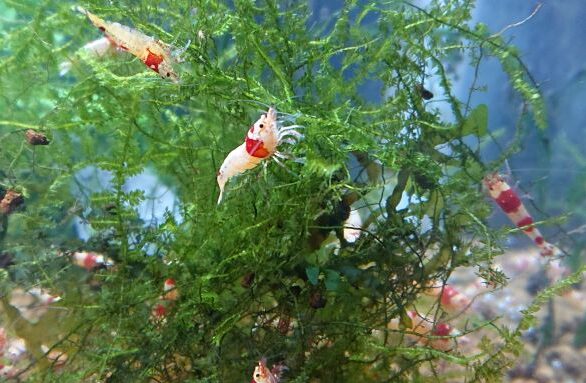Shrimp keeping has become increasingly popular among aquarists. If you’re an aquarium lover, how about considering some shrimps in your tank? And the best part is that by keeping algae-eating shrimps, they’ll help you deal with the algae-growth problem.
Freshwater shrimp breeds that eat algae include ghost shrimps, Red cherry shrimps, Amano shrimps (Caridina japonica), Crystal red shrimps, and Blue velvet shrimps. By keeping them as your cleaning crew, you can keep algae under control.
The rest of this article will explain the above list of freshwater shrimp breeds in detail. So, let’s get started.
Ghost Shrimps
Ghost Shrimp include several shrimp species in the genus Palaemonetes. They’re hardy invertebrates that grow up to 2 inches long. These species are readily available in the market, both for aquariums and as fish foods.
Ghost shrimps are also called glass shrimps due to their transparent bodies. The glass body is a defense mechanism against large fish preying on them. So, before buying ghost shrimps, ensure that they’re transparent, as having other color shades may indicate that they have a disease.
If you want to control algae in your aquarium, ghost shrimp are the perfect breeds for you to consider. They always move around the tank, feeding every alga they come across. Thus, you don’t have to spend time removing these aquatic organisms manually.
Red Cherry Shrimps
Are you planning to keep Red cherry shrimp species in your tank? So, a little information about them will come in handy.
As the name suggests, Red cherry shrimps (RCS) are bright red. Due to their colorful nature, these shrimps are popular in the aquarium market. Thanks to their peaceful character, they’re also one of the best freshwater shrimp species to keep in tanks.
Most RCS are approximately 1 inch long. But their size increases as they grow, and they can get to 1 ¼ inch when mature. Moreover, you can distinguish female red cherry shrimps from their male counterparts by their larger size and bright red color.
RCS are easy to maintain, so you don’t have to use bigger tanks. However, larger tanks are always recommended as these animals need a stable space to survive.
Moreover, RCS can adapt to a range of temperatures. Hence, ensure that your aquarium has between 70° and 80°F (21.1°C to 26.6°C) for them to thrive. Their feeding habit is also one of their appealing features. They can eat almost any type of algae without damaging other live plants you might have in your tank.
Amano Shrimps (Caridina japonica)
Amano shrimps are also known as the Caridina Japonica. You can spot them easily due to dark spots along the sides of their body. However, they have translucent bodies, and you might use them for glass shrimps if you’re not keen.
Amano Shrimp have a larger body size than RCS and grow to about 2 inches long. However, like RCS, their body size increases as they mature. So, they usually grow at a faster rate than the cherry shrimps.
The most exciting characteristic about the Amano species is that they’re the best algae eaters for aquariums. For that reason, most people call them Amano algae-eating shrimp. Therefore, you can also get an Amano shrimps group if you want your tank to be free from foul-smelling algae.
However, Amano shrimp are excellent algae eaters only when they are hungry. So, if you want them to eat every alga in your tank, ensure that you lower the amount of food you feed them. For the best results, you can stop giving them any food for some time as they will have no option but to eat the algae around.

Crystal Red Shrimps
Crystal red shrimps (CRS) are also known as Caridina shrimps. They’re the most beautiful breeds, thus why most aquarists go for them. Moreover, you can quickly identify them from the others due to their unique and vibrant red patches.
However, CRS is highly sensitive to unstable conditions. So, if you use a planted tank, ensure that it’s at least 5 gallons (equivalent to 18.9 liters). Therefore, this water capacity means that Crystal Red Shrimp can survive well in a bigger tank and are vulnerable in the smaller ones.
Moreover, CRS can flourish well in more acidic water. So, to achieve this condition, find a substrate and keep it in your tank. For instance, some aqua soil can help produce organic acids that change the water pH to an acidic level.
Blue Velvet Shrimps
You might have noticed that most shrimp species’ names originate from their appearances. Similarly, Blue Velvet Shrimps have a body structure with blue color ultimately. So, they create a magnificent look in any aquarium.
Moreover, their sizes range from 1.5 to 2 inches long when mature. However, their size depends on how you care for them during their development period. Therefore, if you want your Blue Velvet Shrimps to grow fast, ensure that you provide them with the highest quality habitat.
Now, what about their eating pattern?
Blue velvets eat algae efficiently, and you’ll always spot them feeding on algae filaments in your tank. So, apart from other feeds, algae can act as natural supplements.
Conclusion
Although most freshwater shrimps are omnivorous, some species feed on algae. Therefore, you can incorporate your preferred species from the list of shrimp breeds mentioned in this article to minimize algal bloom in your tank.
Sources
- Shrimp Tips: What are the Best Algae Eating Shrimp
- It’s A Fish Thing: Algae Eating Shrimp: Which is the Best?
- Aquarium Source: 17 Types of Freshwater Aquarium Shrimp You Need To See
- Aquarium Co-op: A Solution to Algae-Amano Shrimp
- Build Your aquarium: 15 Popular Freshwater Shrimp Species(With Pictures): Complete Guide
- Aquarium Source: Blue Velvet Shrimp Care: The Complete Guide
- Tropical Fish Magazine: Red Cherry Shrimp
Recent Posts
How Do Freshwater Shrimps Live? Freshwater shrimp are fascinating creatures that play a crucial role in aquatic ecosystems. They help maintain water quality by consuming algae and decomposing...
How Many Freshwater Shrimp Per Gallon? 4 Key Factors Freshwater shrimp are popular additions to aquariums, but many hobbyists wonder: how many shrimp can comfortably live in a gallon of water? The...

